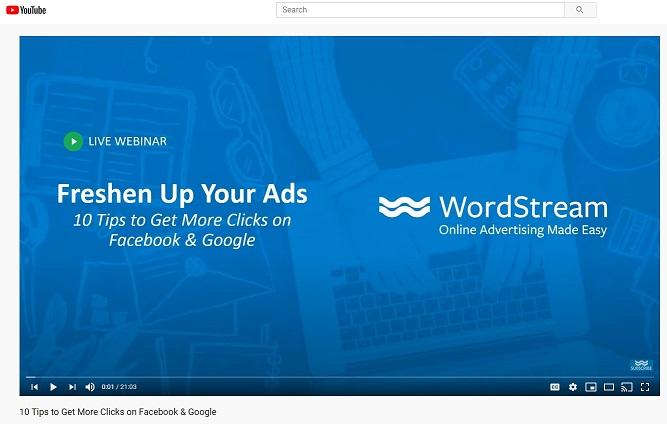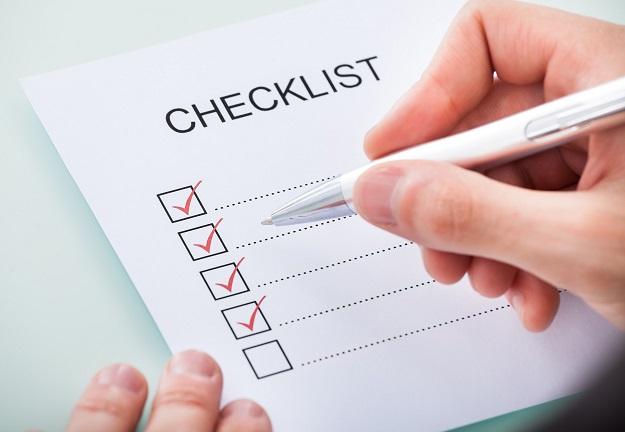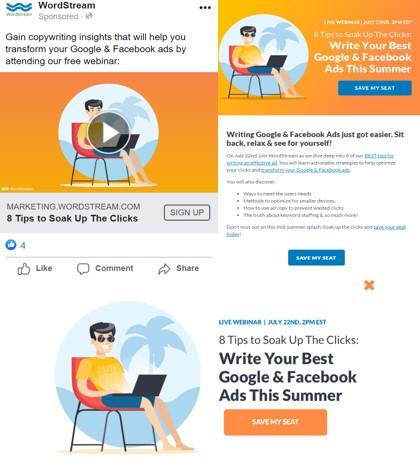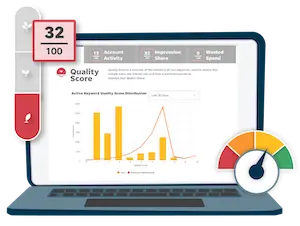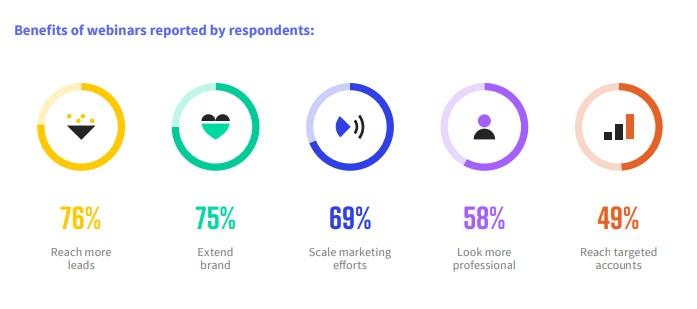
Webinars are a great way to inform and engage your audience. Not only will you be able to generate new leads, but you will also be given a platform to build upon established relationships.
According to ON24, “76% of marketers say webinars allow them to drive more leads” and “75% agree that webinars help them to extend their brand reach,” so leveraging webinars can really help boost your success.
All the webinar benefits covered in ON24’s report.
If you’re looking to leverage your credibility, increase your brand awareness, and drive engagement, you have come to the right place! In order to see any of these benefits from webinar, you need to make sure you’re promoting the event. You need a solid, cross-channel webinar marketing strategy. So in this blog post, we will be sharing six tips we swear by to help you set up your own strategy to make your next webinar a success!
Why do you need a cross-channel webinar marketing strategy?
Before we get into how to create your strategy, you should know why it’s important to have a cross-channel strategy for webinars in the first place.
Here are some benefits you should be aware of:
- It increases your reach. Promoting your webinar through multiple marketing channels allows you to capture a wider audience.
- Through a wider reach, you can gain more registrants since more consumers will be seeing your promotions and have the potential to engage with it.
- Using multiple channels will impress your audience and improve their likeness to convert.
- A cross-channel webinar marketing strategy puts your audience in the driver seat. By showing up through multiple channels, you’re allowing your prospects to engage with your offer in their preferred way.
- It is a great conversation lender for the sales team. The highly engaging format of a webinar makes it a strong touchpoint for sales to start a conversation with a prospect.
Our previous WordStream webinars are also on our YouTube channel.
Now, continue reading to find out six very useful and actionable tips to help you become a webinar marketing pro!
How to create a successful cross-channel webinar marketing plan
Now that we have reviewed the benefits of a cross-channel webinar promotion plan, let’s talk about some tips so you can put this plan into action.
1. Plan, plan, plan!
When it comes to making a webinar, you can never plan enough. Here are some tips to help you stay organized and on top of things:
Create a schedule. When it comes to scheduling, it is important to think about every detail. Some things to think about when scheduling includes:
- What the best day would be to host the webinar?
- What time should the webinar be at?
- When you should begin to promote the webinar?
- When each email invite should be sent out leading up to the webinar.
Brainstorm as a team. Brainstorming all together can be an effective and fun way to come up with interesting and exciting webinar topics.
Choose your marketing channels. Before you get too far, nail down where you’re going to promote the webinar in your cross-channel approach. You can stick to standards like paid search and social, email marketing, or test out other marketing channels. We’ll talk more about this when we get into audience targeting in just a minute.
Make a checklist. Making a checklist can help you keep track of what has been done and what still needs to be completed—so that no step is overlooked or forgotten about. At WordStream, we use a Google Sheet as a collaborative tool to stay organized and on track.
Establish ownership. In order to make it clear who is doing what, it’s a good idea to make a webinar plan that outlines ownership. (Pro tip: Make sure you add this ownership to your Google Sheet or checklist.)
Stay aligned with your team. It’s important to communicate and be on the same timeline as others. Here at WordStream, our team stays aligned during webinar marketing by:
- Communicating over Slack.
- Checking the schedule for webinar processes.
- Sharing performance results and insights.
2. Nail your audience targeting
A cross-channel approach allows you to find your target audience no matter where they are or what channel they are using. By figuring out who your prospects are and what personas you are working with, you will be able to personalize your ads based on their behavior and needs. Here are some tips we employ in our core channels when promoting our webinars.
Facebook recently hit a new record of 2.6 billion monthly users. This extensive reach provides a great place for advertisers to reach and convert new prospects for their business. This is why we go to Facebook as a powerful channel to convert webinar registrations as part of our cross-channel approach. We’ve found that lookalike audience targeting performs the best—as we’re reaching prospects who show similar interests to our seed customer and website lists.
Here’s an example of an ad we personalized towards a lookalike audience of users interested in Facebook advertising:
Another great place to promote your webinar is on your website—particularly if you have educational content hosted on your site. Users who engage with resources on your website are likely to be interested in further educational offers, which makes your webinar a powerful CTA. For WordStream’s webinar promotion onsite, we determine our target audience based on user’s behavior and content engagement.
With email marketing, understanding your database segments will help you nail your targeting. In breaking down your database, you should consider:
- Activity: Review your database’s recent activity to understand their likelihood to convert or engage with your webinar promotion.
- Stage: You should also consider the funnel stage of your prospects. This will help personalize your promotion based on their familiarity with your brand and other offers.
3. Be consistent in your promotions
Consistency is key when you are using multiple channels in your promotion strategy. Aligning your creative and message makes your promotion cohesive and effective as prospects see your promotion through multiple touchpoints. Not only do you want your promotion to be relevant to your audience, but you want scroll-stopping and compelling creative that will catch your lead’s eye and ultimately influence them to take the action
To show an example of consistency, let me share what we did for our most recent webinar last month. Our promotions spanned across email marketing, Facebook advertising, and pop-ups on our website. We incorporated a consistent theme in every creative and aligned on our copy. Here’s an example of our email, Facebook, and web promotions:
In these examples, you can see how consistent each promotion is with each other by employing a common summer theme. By being consistent in our promotions, our consumers will be able to make a connection between the channels and may be more inclined to engage with our content.
4. Consider what you can A/B test
You should always be testing! By A/B testing, you can gain a better understanding of what works best for your audience. Keeping a log of what variables win in your tests will help you make your future promotions even better, allowing you to build on your learnings.
There is so much you can learn when you A/B test. But remember to only change one variable at a time so it is easier to analyze and understand what is really driving the change in numbers.
Some ideas that would be smart to test are:
- Messaging: Find out what CTA is the most effective for you.
- Title: See if a simple or themed title would be more engaging for your audience.
- Creative: Learn what ad formats work best in your channels.
- Seasonality: Determine if there is any seasonality in the engagement of your webinar promotions.
- Topic: Figure out which topics resonate best with your audience.
- Promotion timeline: Test different promotion timelines to understand what the most effective time would be to begin promoting your webinar before the live date.
- Day of the week/time of the day: Establish what day and time generates the most registrants for your promotions.
Here’s an example where we A/B tested the title in our webinar promotions:
Here we controlled one variable: the title.
5. Set goals for each channel you plan on using
Setting goals will allow you to measure your success while also motivating your team to work towards a unified goal. (Spoiler: You’ll notice in the next point, we share tips on how to review performance which will drive the goals you set.)
We find that webinar registrations is a great centralized objective to align your webinar team to, and it’s one goal you can set for each marketing channel. Make sure you keep a log of your historical webinar performance, as well. This will allow you to reference benchmarks and compare performance when setting new goals.
6. Review performance
Last but definitely not least, reviewing your performance is a good way to determine what worked and what didn’t work for you. By discovering your strengths and weaknesses, you can discuss your learnings and what you can improve on for next time.
There are endless metrics to review in your cross-channel performance—through your social metrics, webinar platform analytics, and other reporting tools in your tech stack. But we’ve found that the foundation to analyzing our webinar promotions is reviewing registration numbers and attendee engagement. We document these results in a shared report so we can stay on top of benchmarks and core KPIs that we can set out to improve for future promotions.
Use this cross-channel webinar marketing checklist
Just to recap, webinars are a great marketing tool because they are highly engaging and full of value. Webinars help grow your business through promoting brand awareness and generating full funnel impact. We want to help you build a successful cross-channel webinar which is why we provided the following six tips to help guide you in the right direction:
- Plan, plan, plan!
- Nail your audience targeting
- Be consistent in your promotions
- Consider what you can A/B test
- Set goals for each channel you plan on using
- Review performance
So put these tips to use and report back on your success!

